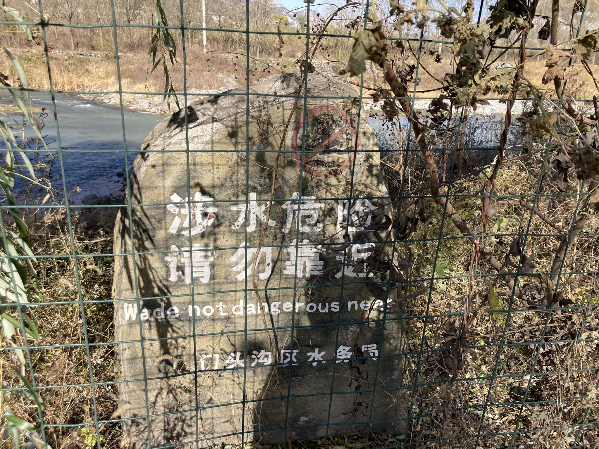Wade not dangerous near
« previous post | next post »
From Geoffrey Wade, of all people:
shè shuǐ wéixiǎn
qǐng wù kàojìn
涉水危险
请勿靠近
wading is dangerous
please don't get near
It's been quite a while since we've seen one this bad. They fairly murdered it, not even understanding the force of the negative.
Selected readings
- "Slip carefully" (5/6/14)
- "Sino-Japanese faux ami" (4/23/17)
- "Don't eat the water" (3/17/15)

Mark Hansell said,
November 3, 2021 @ 3:14 pm
It looks like it was parsed wrong and then translated: two characters at a time, top to bottom, left to right—
sheshui –> wade weixian –> dangerous
qingwu –> not kaojin –> near
KeithB said,
November 3, 2021 @ 3:30 pm
I see it as poetry:
Wade not;
Dangerous Near;
ExTex said,
November 3, 2021 @ 5:33 pm
Really, that semicolon was all it needed. But punctuation is beyond a great many native speakers. Imagine what a nightmare it is for learners.
Su-Chong Lim said,
November 3, 2021 @ 8:42 pm
It’s Yoda-speak
unekdoud said,
November 4, 2021 @ 2:13 am
I also interpret this as the rearranged warning "No wading / Danger nearby" and not the direct translation.
Cervantes said,
November 4, 2021 @ 10:39 am
Yes, it's interesting that in spite of the totally mangled translation, the result is intelligible and pretty close in meaning. Even without punctuation, the reader will understand it as "Don't wade, area is dangerous."
Scott P. said,
November 5, 2021 @ 8:28 am
Even without punctuation, the reader will understand it as "Don't wade, area is dangerous."
Not quite. There are two places one could place the semicolon:
Wade not; dangerous near
OR
Wade; not dangerous near
Kris said,
November 5, 2021 @ 10:42 am
@Scott P.
Except, there'd be no need to place a sign somewhere saying "everything is safe here, proceed as you like," which makes the second interpretation one that can be ruled out by pragmatics. Otherwise such signs would be ubiquitous. Agree with others that the intended meaning isn't that opaque: don't wade, it's dangerous near(by).
Matt said,
November 5, 2021 @ 5:12 pm
@Kris
“ Except, there'd be no need to place a sign somewhere saying "everything is safe here, proceed as you like," which makes the second interpretation one that can be ruled out by pragmatics.”
Here in Australia we famously place red and yellow flags on the beach where it is safe to swim… the implication being it is unsafe to swim anywhere but here (where there are typically no signs).
So it seems perfectly reasonable to me that a river that is dangerous to cross in other places would have a sign marking a location where it is safe to cross.
That said, given the ambiguity involved by the broken English, I would guess that it was unsafe, or at least decide not to take my chances.
Thomas said,
November 7, 2021 @ 6:46 am
I just now realized that 危险 is pronounced differently in Taiwan (wéi) than on the mainland (wei1). The more you know.